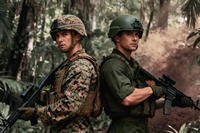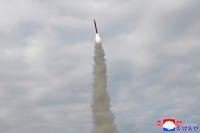The Marine Corps is in the market for a new body scanner that can help officials equip Marines with the best-fitting body armor and gear -- and it will even show how to squeeze leathernecks wearing full battle rattle into tactical vehicles.
The service recently published a solicitation for a full-body high-resolution anthropometry scanner capable of capturing 3D images of individuals, still and in motion, for the purpose of collecting data on what the average Marine looks like.
According to the solicitation, posted June 24, the scanner must be able to capture at least 20 seconds of motion, with at least 10 frames or full scans per second and a minimum of 30 different body measurements.
"The purpose of the anthropometry scanner is to conduct an update to the 2010 Anthropometry Survey of the Marine Corps with a new technology scanner," officials with Marine Corps Systems Command said in a statement. "Anthropometry data is critical for the design of clothing and equipment, and modern scanning technologies provide our engineers with enhanced tools to better equip our Marines. The scanner will also be used to generate 3D scans of Marines fully equipped for use by designers for seating in vehicles."
A command spokesman, Maj. Ken Kunze, told Military.com that the precise timeline for the new survey had not yet been determined, as it was dependent on contracting, but it's likely to start next year. The Marine Corps conducts the surveys every one to two decades, gathering data from thousands of troops to assess averages across the service.
This data comes into play when the Marine Corps is determining fit for new protective gear and other items. In 2016, as the service opened more ground combat jobs to women, it expanded the size range of its stock of personal protective equipment. Previously, gear had to fit the 5th to 95th percentile of men, according to survey data; now, sizes must range to fit women in the 2nd percentile up to men in the 98th percentile.
The 2010 survey included 1,301 men and 620 women, who were measured directly and 3D-scanned. Data was sorted by race, gender, age and geography, and averages were compared to those from the previous survey, conducted in 1994.
Although Marines are required to meet height, weight and fitness standards, there's precedent for finding that the average service member is getting bigger over the years. From 1994 to 2010, average height measurements for women stayed roughly the same, but weight increased an average of almost 4 pounds, corresponding to bigger average waist and buttocks measurements. Likewise, male Marines were almost 3.5 pounds heavier on average, and had bigger waists, buttocks and feet, although height stayed about the same.
But the Marine Corps has also gotten more scientific and deliberate about the way it conducts body-size surveys since it began them in 1966. In 2010 the Corps completed its most wide-ranging and precise survey yet, working to ensure that the age and demographic distribution of survey participants mirrored that of the service. In the past, this wasn't always true; the 1966 survey in particular was predominantly weighted toward young Marines, with 66% of participants under age 21.
"The anthropometric consequence of that dramatic difference in age distribution is that many of the weight-related dimensions would naturally be larger in the samples with older Marines," the 2010 survey analysis noted. "Apparent differences seen between 1966 and the two later studies are partially a result of changes in the body size and shape of Marines over the 45 years and partially a result of differences in the age distributions."
Kunze said he couldn't say yet where the Marines who will participate in the survey will be drawn from and how many will be measured, but said he expects every part of the Corps to be represented.
-- Hope Hodge Seck can be reached at hope.seck@military.com. Follow her on Twitter at @HopeSeck.













